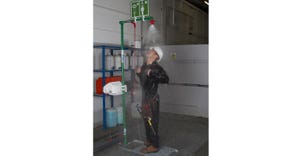Ultrasonic Sieving in the Powder Coating Industry
October 26, 2012
Over the past few decades, the powder coating industry has seen double-digit growth in the U.S. and Europe. Many new markets have emerged to take advantage of this high-performance film coating. With its superior toughness and chip resistance and the simple method for overspray recovery, powder coating has proven to provide exceptional coating properties over conventional liquid paint systems. However, over the past few years, with a slowing market and rising raw material costs, manufacturers are being forced to look even more closely at all aspects of their business to maintain growth and healthy profitability.
The Process
Continuous growth since 1969 has brought Jotun Powder Coatings to a position among the leading global powder coatings manufacturers for industrial and domestic surface treatment. With factories in 11 countries, and a reputation for being able to offer the most advanced and technically protective products, Jotun determined that updating its powder coating check-screening process before the filling lines would eliminate product contamination and reduce waste.
Powder coating is entirely a dry finishing process. It is composed of grinded particles of resins, pigments, and other raw materials that are electrostatically charged and sprayed onto objects to be coated.
The powder coating process (see Figure 1) involves a number of steps taking the raw materials through various stages to form a ‘plastic’ mix. The mix is then cooled and broken down into plastic chips before being micronized (made into a powder form) and passed through a cyclone classifier to separate the large and fine powder particles. Finally, the fine powder is check-screened to remove extraneous contaminants such as filter bag ‘fluff’ and oversize powder particles caused by material that has polymerized during up stream processes. Check-screening the powders at this stage ensures only powder of the correct particle size is passed through to the filling line (See Figure 2).
Check-screening is critical because particle size will have a direct impact on the quality and film thickness that can be obtained during the coating process. Too thin will result in an inadequate coating, while too thick will waste money.
Traditional Methods of Check-Screening – Problems Faced
Jotun had used rotary screeners for sieving impurities from its products for many years. While the centrifugal action of the rotary screeners removed some impurities, very little oversize powder was collected during the screening process.
Another major problem with the rotary machines was screen breakage. The screen mesh is made of nylon, which is prone to breakage. This severely disrupted production as the operators were required to dismantle the machine and replace the broken screen. Also, because the rotary screeners were enclosed, operators were not always aware when the screen mesh had broken, meaning that the entire batch of powder would need to be re-screened again to remove the contamination caused by the broken pieces of nylon screen mesh.
With constant use, the apertures of the nylon screen mesh start to change size (much like the strings of a tennis racket). A screen with non-uniform aperture size allows oversize powder particles to pass through the rotary screener resulting in a poor quality coating. Powder coatings users desire no rejects due to inferior finish.
Since the powders in coating processes are designed to hold a static charge, this has traditionally caused problems during screening due to blinding and blocking of the mesh apertures, compromising both product quality and sieving capacity. To overcome this, some manufacturers have experimented with ‘off-line’ screening but this has led to quality control problems.
Gravity-fed circular vibratory sieves are the preferred method since they ensure only particles below the aperture size of the mesh pass through to the filling lines. Historically, spring-mounted sieves have been used, but these are difficult to dismantle, resulting in long and laborious clean-down times. With the recent changes in the market, batch sizes are reducing, creating a need for more frequent product changeovers. This has resulted in an increase in production downtime and costs due to the amount of time taken to clean down equipment. Manufacturers have become more aware of this process inefficiency and started to look at alternative solutions.
The Solution – Compact and Easy-Clean Screening
All of those problems were completely eliminated when Jotun replaced its rotary screeners with compact vibratory screeners from Russell Finex.
Russell Finex has been supplying separation solutions to the coatings industry for many years and has developed a solution for this application. By combining its Compact Sieve and Vibrasonic deblinding system, an efficient screening system can be obtained.
The Compact Sieve has a low-profile, ‘straight through’, in-line design enabling higher production rates when compared to other vibratory sieves. The small footprint helps when space requirements are often limited, but capacity levels must remain high to ensure there are not bottlenecks in the process which would compromise profitability. Having the motor mounted on the side also means the unit can be installed mid-platform or on a mobile stand, allowing filling lines to be installed directly underneath the product outlet saving space (see Figure 3).
Another fundamental feature of the sieve is that it uses only stainless steel mesh, which is much stronger than nylon and less prone to breakage as well as aperture deformation. The sieve also has view ports to allow operators to inspect the screen during operation.
Idar Larsen, project manager at Jotun A/S states, “Any risk of product contamination has been eliminated completely with the Russell compact screeners. Compared to the rotary units we replaced, they are very simple to dismantle and clean. In addition, we no longer have pieces of nylon mesh finding their way into the product which was a frequent problem we experienced with the rotary screening machines.”
When changing colors it is essential that the process lines are thoroughly cleaned to prevent cross contamination of batches. Unlike conventional spring-mounted or rotary sieves that are notoriously difficult to dismantle and clean, the Compact Sieve has a hand-operated clamping system that enables the unit to be dismantled in seconds without the need for tools. In addition, having a crevice free design with few product contact parts makes cleaning this sieve effortless.
Due to the characteristic of powder coatings a static charge can often build-up on the sieve mesh, resulting in mesh blinding and blockage. This reduces the useful screening area and the screen’s overall capacity, slowing down production rates (see Figure 4).
Many companies try to clean their screens manually, but this can often cause damage either through incorrect handling or cleaning methods, resulting in premature mesh failure. Other companies use screening systems that incorporate mechanical devices such as discs or balls that bounce up and down, hitting the screen and shaking free any blockages. Unfortunately, the action of these discs can also damage and reduce the life of the mesh. Even more seriously, as these devices wear down, pieces of their rubber or plastic construction can fall off and contaminate the powder being sieved.
The Russell Vibrasonic deblinding system applies an ultrasonic frequency to vibrate the sieve mesh (see Figure 5). This breaks down the surface tension, effectively making the stainless steel wires friction-free. The system has no mechanical or wearing parts, so there is no risk of mesh damage or product contamination. Because it prevents the mesh from being blocked or blinded, it ensures the screening capacity and throughput remains constant throughout the production process. Downtime for cleaning is also reduced while increasing mesh life due to the reduction in manual handling. This also means that less good powder is wasted.
Both the Compact Sieve and Vibrasonic system can be specified to match existing milling systems to ensure production rates are upheld (see Figure 6).
“With the introduction of the Russell compact screeners we have seen a dramatic increase in our screening efficiency, providing us with significant advantages,” Larsen added. “This means that only oversize particles are ending up in the oversize fraction. With the traditional rotary screening machines we were using, a lot of good product ended up in the oversize fraction.”
In order for powder coatings producers to survive in this ever-increasing competitive industry, embracing new technologies to improve the efficiency of manufacturing processes is essential to ensure that product quality is upheld while ensuring profitability is maximized.
For more information, visit www.russellfinex.com.
You May Also Like


